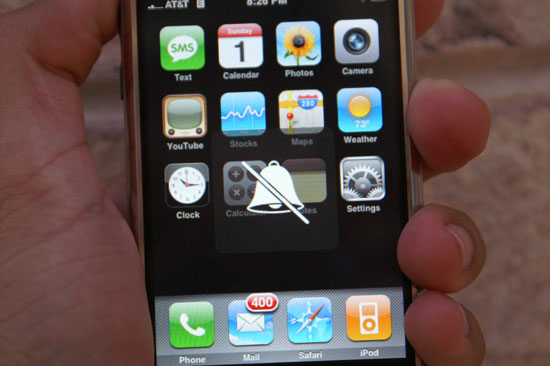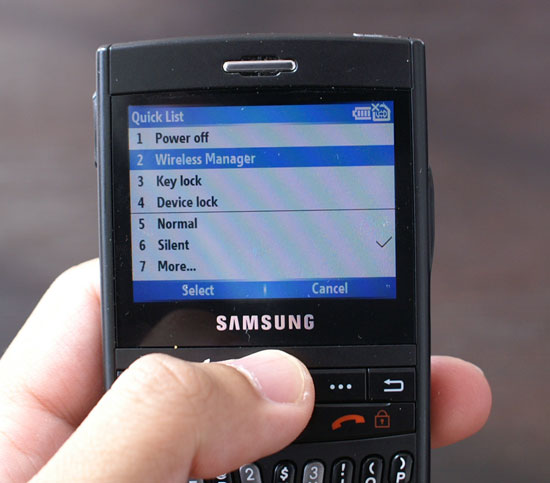Apple's iPhone: The Future is Here
by Anand Lal Shimpi on July 2, 2007 6:13 PM EST- Posted in
- Smartphones
- Mobile
Simplicity Perfected
The iPhone has four physical buttons on it, and honestly you don't need any more. On the front of the phone is the home button, which takes you to the home screen regardless of what you're doing. The home button isn't an iPhone exclusive, many phones have it, including Samsung's Blackjack. The button is key for switching between tasks; say you're writing an email but decide you want to check a fact on wikipedia or you just remembered something that you want to SMS to a friend, hit the home button and fire up Safari or the SMS client, do what you need to do and then switch back to your email to pick up where you left off.

Take me home tonight
Hitting the home button doesn't close any applications, it merely switches back to your iPhone desktop. The home button is your iPhone's Alt (or Cmd) Tab, it's your ticket to quickly switching between applications; one press of it and a touch later and you're in another application. The functionality is perfected by the fact that the iPhone's user interface is incredibly responsive, switching between applications works like a computer, not a mobile phone.

The ringer toggle switch is set to silent, hence the visible red dot
Along the left hand side of the iPhone are two switches: a volume rocker and a ringer toggle switch. The volume rocker works as you'd expect it to, during a call or audio playback it will adjust the volume of the earpiece or speaker, otherwise it will adjust ringer volume. Mac users should find the on screen display comfortingly familiar:

Home sweet home...for OS X users
The ringer toggle switches between normal and silent ringer modes; these are the only two profiles you can configure on the iPhone and even then, they aren't very configurable:

In silent mode, all audible notifications are disabled and the iPhone will only vibrate to alert you of an incoming call/message/email. You can disable the vibrator so that the iPhone is completely silent and motionless in this mode, but that's all.

Silence!
In normal mode, the iPhone will ring, bark, beep or boing at you as loudly as you have the volume set. In addition, it will also vibrate to give you the complete aural and tactile experience. You can control what events will trigger sounds, but that's as far as the customization goes.
For me personally, this is all the configurability I need when it comes to custom profiles. I usually keep my phone on vibrate, and if I want an audible notification as well a flick of a switch is all I need on the iPhone. I've never really used profiles on my Blackberries and Windows Mobile Phones of years past, mostly because there are way too many keystrokes associated with switching between them all.
On the Blackberry Curve, you have to scroll to profiles and select the one you want. It seems silly to complain about using a trackball and having to make two clicks to change a profile, but compared to flicking a single switch that you can do without staring at the screen, it is a big deal.

Profiles on the Blackjack
To switch profiles on the Blackjack you have to hit the power button and select from a list. Thankfully Samsung included a silent mode button on the keyboard itself, just hold it down and your phone is silenced. The only issue with Samsung's implementation is that the button is sandwiched between the spacebar and comma keys, not the easiest to blindly select.

From left to right: sleep/wake button, SIM tray, 1/8" headphone jack (recessed and very particular about what headphones it'll work with)
The only remaining button on the iPhone is along the top of the device, and it is Apple's Sleep/Wake button. The button is stiff enough where it won't accidentally get hit in your pocket, and just like the ringer toggle you can easily activate it without looking at the phone. Hitting the sleep/wake button while your iPhone is on and active will shut down the screen, pause whatever you're doing (e.g. web pages will not continue to load while the phone is asleep) and lock the interface. Tapping on the screen won't wake it back up, you either have to hit the home button or the sleep/wake button again. Doing so will bring up this screen:

And simply slide your finger where indicated to unlock the phone (which is very cool by the way); if you've got a password set, you'll be asked to enter it next. Just like the ringer toggle, the sleep/wake button is ridiculously useful yet overlooked on many cellphones. The Blackjack lets you lock the phone by holding down the end call key for a few seconds, while the Blackberry requires you manually select the lock button from the phone's interface (or if you have dial from home disabled, just hit the 'k' key). Both competitors at least offer an alternative, but neither is as easy as the iPhone's dedicated button.
The rest of the iPhone's interface is completely virtual, driven by the 3.5" mult-touch LCD. Know what you're getting into with the iPhone; on first glance it seems overly simplified, but if your needs and its abilities mesh, it truly is a phone interface done right.










85 Comments
View All Comments
EODetroit - Tuesday, July 3, 2007 - link
Holy Comprehensive Review Batman! That took most of my morning at work, good thing its practically a holiday here already.Now my question is:
How many poop pictures has Anand received from the A-Tech staff?
Haha
Shimmishim - Tuesday, July 3, 2007 - link
Yes. It was a good read. One of the best reviews of any piece of hardware (computer or consumer related) I've read in a long time.Anand Lal Shimpi - Tuesday, July 3, 2007 - link
Thanks guys :)And no, zero poop-pictures from AT staff.
Take care,
Anand
LoneWolf15 - Tuesday, July 3, 2007 - link
While not perfect as a product either, Anandtech completely skipped any Palm Treo devices for this comparison. The Treo has done SMS by contact for some time now, just as you have mentioned the iPhone does (I've had it on both the 650p and 750p; I'm sure the new 755p does as well). While I have some issues with Palm support as far as their product goes, I still haven't seen a smartphone that can do better --I blame this at least in part due to carrier wars and desire for control (i.e., crippled Bluetooth, not adding WiFi, so carriers can make you pay for everything through them), rather than blaming cell phone manufacturers.Anand Lal Shimpi - Tuesday, July 3, 2007 - link
There were a number of products I would've liked to have included, but I was very limited by time so I tried to shoot for two of the most popular: the Curve and the Blackjack. I've already dropped Nokia an email but I'll do the same for Palm and see what comes of it :)Take care,
Anand
retrospooty - Tuesday, July 3, 2007 - link
Ya, quite alot of things like that the Treo has done, and done well for a long time now, all that and an open platform. The issue is the latest Treo is, 4 years later, still the same repackaged Treo, with a few minor upgrades. The iPhone is by far the best UI, and that alone will be its saving grace, and its legacy on the industry. A few years from now, REAL smartphone manufacturers will copy the UI and improve everything, and do it cheaply, and on all carriers. That is the best thing about the iPhone.LoneWolf15 - Tuesday, July 3, 2007 - link
Actually, in 4 years, the Treo added Bluetooth (the first 600p didn't have it), EVDO (the iPhone has only EDGE, which has been rated far slower, and slowest when provided by AT&T/Cingular, the single carrier of the iPhone), an SD card slot (600p didn't have one), and several other features.As I said, the Treo isn't perfect. And I think the UI of the iPhone is pretty spiffy, plus I'll bet it has the best web browser of any phone on the market. But I don't think I could do without a real (by real I mean tactile) QWERTY keyboard (I rely on text messages for work, since cell reception can be spotty in a reinforced concrete building), I like having EVDO support, and I like the fact that I can choose from Sprint, T-Mobile, Alltel, Verizon, or AT&T Cingular for a Treo (AT&T/Cingular has little or no reception in my work area, so it nixes any thought of an iPhone, and by my understanding, they have a five-year exclusive agreement with Apple). And I can get a Treo for a few hundred less as well.
I want to like the iPhone. Unfortunately, Apple set conditions of pricing and carrier that mean I'll never find out how good a phone it might really be.
sviola - Tuesday, July 3, 2007 - link
Not only the Palm Treo, but the Nokia N95, which is just awesome:In-built GPS and Navigation Program (over 100+ countries maps)
5 MP Camera with Zeiss Lens and Optical Zoom, and Video Recording
Symbian OS
Plays MP3, video, etc
Bluetooth, Wi-Fi, USB, TV out
Quadriband GSM/WCDMA (3G)
MicroSD Card Reader
Among many other features.
rowcroft - Tuesday, July 3, 2007 - link
The iPhone looks great, but the big gotcha for me is that I routinely use my 8525 to access the internet on my laptop. Can't do that with the iPhone from what I understand.As for all the comparisons to Verizon & such, if you look at the total cost of ownership (Verizon's data plan is significantly more expensive), the iPhone is just a few dollars cheaper than the Blackjack w/Verizon.
Locutus465 - Tuesday, July 3, 2007 - link
I've got a Samsung i720 with verizon... For a "last gen" PDA phone priced at just $100 brand new from verizon when I got it, it's pretty sweet. Admitingly the display isn't quite as good as apples, but as far as functionality it does everything the iPhone does and more. I also appriciate the sliding screen with which reveals a keyboard. There's also the other advanatages I mentioned earlier, i.e. Windows Mobile being open to 3rd party development etc.